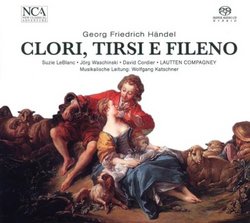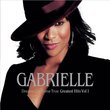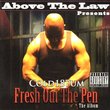| All Artists: Handel*G.F. Title: Clori Tirsi E Fileno Members Wishing: 0 Total Copies: 0 Label: New Classical Adventu Original Release Date: 1/1/2008 Release Date: 1/1/2008 Album Type: Import, Super Audio CD - DSD Genres: Pop, Classical Styles: Vocal Pop, Opera & Classical Vocal Number of Discs: 1 SwapaCD Credits: 1 UPCs: 885150601884, 4019272601880 |
Search - Handel*G.F. :: Clori Tirsi E Fileno
 | Handel*G.F. Clori Tirsi E Fileno Genres: Pop, Classical
|
Larger Image |
CD DetailsSimilar CDs |
CD ReviewsA voice teacher and early music fan George Peabody | Planet Earth | 08/08/2009 (5 out of 5 stars) "THIS IS THE ONE!AND HALLELUJAH! IT'S BEEN REISSUED AT A REASONABLE PRICE!
There are a few other recordings of this work listed, but I would be mildly surprised if they could match the quality of performance of this one. In this work, scored as it is for three treble voices, the combination of singers is crucial to the differentiation between the voices. It's really quite annoying if you can't detect who is singing at a particular time. The first time I listened to this particular recording about eight years ago, I could immmediately detect the individual singers without the annoyance of looking it up in the line-up. The trio of singers herein project the most authentic sound quality for this pastoral-like setting by George Frederick Handel (1685-1759). This was written in his early years when he was much impressed with the Italian works, particulary one of the leading vocal forms of the day, the Chamber Cantata, in both its religious and secular versions. Its partly narrative and partly dramatic literary structure, demanded a theatrical setting. The texts were written in a variety of metres and this allowed the composers to vary the sequence: recitative-aria-recitative. This means that da-capo-arias can be found next to ariosi and arias in verse form, and there are semi-narrative lyrical arias some of which are dramatised or partly dramatised. The preferred literary theme was love, with all its ramifications as put forth at that time by the Arcadian Academy. All of this the young Handel adopted with great vigor into his compositional style, and as a result we have a wonderfully entertaining composition such as "Clori, Tirsi and Fileno". However, begining from the 'chamber cantata' premise makes for a rather complex score, as much for its dramatic plotline as its musical options: the end result is really a genuine opera in miniature, equipped with real refinement and lightness. Handel, in fact, has turned this into an authentic laboratory in which he experiments with the most divine musical and dramatic forms. It was performed in Rome in 1707; it is a piece of witty erotic pastoral delight. The story centers around the shepherdess, Clori (soprano-Suzie Le Blanc), who we discover is happily playing her two lovers against each other, the lovers being Tirsi (male sopranist-Jorg Waschinski), and Fileno (male alto-David Cordier). When they find out what she's been up to they reject her, and she leaves them for somebody new. Meanwhile Tirsi and Fileno decide that they might be better off with each other!!!! The performance by these highly skilled singers is quite incredible, both dramatically and vocally. Waschinski has a really phenominal voice reaching very high notes with clarity and power, but in no way can his voice be mistaken for a female soprano. You have only to hear and believe. David Cordier, male alto, has a wonderfully rensonent voice throughout his very wide range. In fact, on many recordings he sings soprano, and with just as much strength and evenness as in his lower range. La Blanc literally 'floats' effortlessly through the phrases in all her arias, with a beauteous sound displaying excellent technical facility. The ensemble 'Lautten Compagney'(seven in all), directed by Wolfgang Katschner, presents an appropriate accompaniment demonstrating some fine instrumental playing. This 75 minute recording was a listening pleasure from beginnng to end! Handel's vocal and instrumental score is written with his usual expertise; it is clever and there is much variety throughout. The liner notes are in German and English; however, the libretto is in Italian and German (no English). Didn't bother me because the story is simplistic and it is quite simple to follow it. I would mention that there is another setting of this story (almost exact)by Giovanni Bononcini, scored for soprano, countertenor and baritone. It's available and it's called : "La Nemica D'Amore Fatta Amante". Also most enjoyable. " |

 Track Listings (29) - Disc #1
Track Listings (29) - Disc #1



